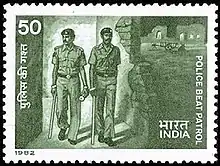Beat (police)
In police terminology, a beat is the territory that a police officer patrols.[1] Beat policing is based on traditional policing (late 19th century) and utilizes the close relationship with the community members within the assigned beat to strengthen police effectiveness and encourage cooperative efforts to make a safer community. Beat police typically patrol on foot or bicycle which provides more interaction between police and community members.[2]
.jpg.webp)
Before the advent of personal radio communications, beats were organised in towns and cities to cover specific areas, usually shown on a map in the police station and given some sort of name or number. Officers reporting on duty would be allocated a beat by their sergeant and sometimes given a card indicating that the officer should be at a particular point at set times, usually half an hour, or forty-five minutes apart. The points would usually be telephone kiosks, police pillars or boxes, or perhaps public houses where it would be possible to phone the officer should he be needed to respond to an incident. The officer would remain at the point for five minutes and then patrol the area, gradually making his way to the next point.
Beats in town centers would be relatively small areas but in the suburbs much larger. A shortfall in manpower would mean that one or more beats would be left unpatrolled at the discretion of the duty sergeant.
Sometime during an officer's shift, he could expect a supervisory officer to meet him at one of the points. This ensured the beat patrol was being correctly carried out and was an opportunity to discuss problems. The supervisory officer would sign the officer or constable's pocket book, ensuring that it was up to date.
It was expected that a constable would learn all about each beat he covered, even though they would not necessarily be the same one each shift. A new constable would usually be shown around the beats by an experienced constable who would point out important considerations. These would include vulnerable premises such as banks and post offices, perhaps showing the officer where a peephole would give a view of a safe. A constable was expected to learn where known criminals resided or resorted and which public houses might be the source of problems or keeping late hours.
The same principles extended to beats patrolled on bicycles or in motor vehicles. Even with radio communication, the patrol vehicle would be expected to visit and remain at certain points at particular times, enabling supervisors to meet up with the patrolling officer or to give a visible police presence at times when this was deemed particularly needed.
Missing a point without good reason was regarded very seriously and was often the cause of disciplinary action against an officer. Beat officers were commonly used in the 1800s.[3]
Reduction

The move to motorised patrols such as Panda patrols in the 1960s greatly reduced the priority given to foot patrols.[4] Also a factor was the consolidation of smaller local police forces in the Police Act 1964. Portable police radios first appeared within the British police in 1969. Chief Constable Capt. Athelstan Popkess is credited with being largely responsible for transforming the British Police Service from its Victorian era 'beat policing' model to the modern reactive response model, through his development of the 'Mechanized Division'.[5] Under his stewardship from 1930 - 1959 Nottingham City Police were the first force nationally to develop the use of two-way radio communication and utilise this to be able to deploy mobile police patrol cars remotely and also receive updates from them in return, as early as 1931.[6] Popkess and the Nottingham City Police would expand this pioneering method and develop tactics to use it to its full potential including overlaying mobile patrol areas on top of several existing foot beats, allowing responding Mechanized Division officers to collect colleagues on foot and take them to incidents; 'snatch plans' to pot up police cars at key road junctions in the event of serious crimes; and 'Q-cars' or 'Q Cruisers' - unmarked vehicles disguised as civilian cars or delivery vans for covert patrol.
See also
- Community policing – Strategy of policing centered on building close ties with communities
- History of law enforcement in the United Kingdom
- Peelian principles – Philosophy defining ethical police force
- Preventative policing
- Proactive policing – Police presence for crime deterrence
References
- David Cross (2011-02-17). "On the Beat in Birmingham". BBC News.
- "What is a Beat Cop?". wiseGEEK.
- "Lincoln Police Department History". Lincoln Police Department. Retrieved 2014-03-12.
- "Pandas on parade as East Lancs force shows off new fleet".
- Andrews, Tom (2020). The Greatest Policeman? A Biography of Capt Athelstan Popkess CBE, OStJ Chief Constable of Nottingham City Police 1930 - 1959. Blue Lamp Books. ISBN 978-1911273899.
- Popkess, Capt Athelstan (1 January 1933). "Pursuit by Wireless: The Value of Mobility". The Police Journal: Theory, Practice and Principles. 6, 1.